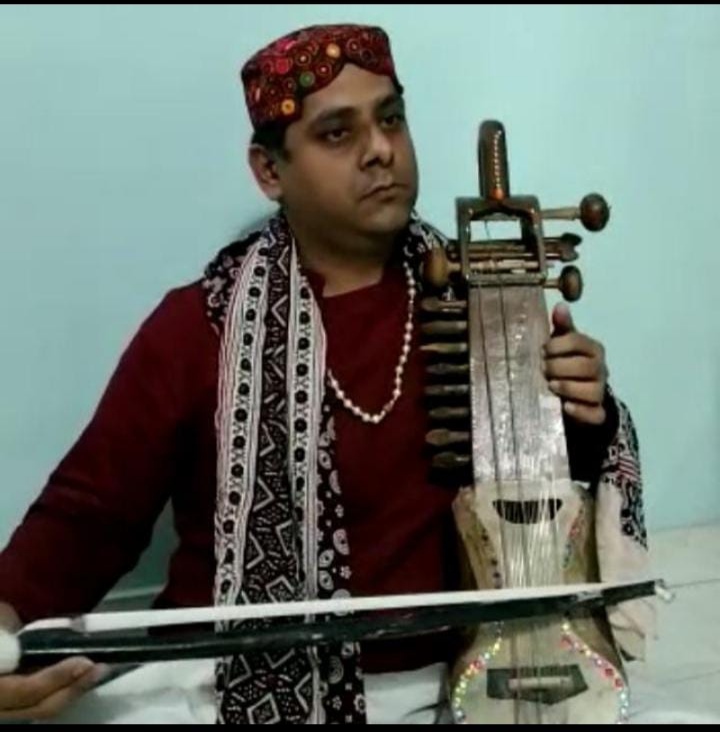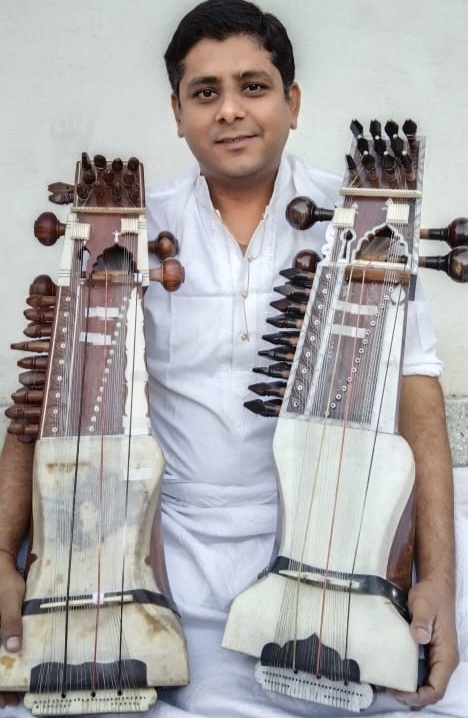
Rajesh intends to hold Sindhi Sarangi Workshops and such other programs in India
Sindh Courier Report
Rajesh Kumar Parasramani, a renowned Sarangi player based in Chhattishgarh, has founded Sindhu Gharana to promote Sindhi Sarangi in India and abroad.
‘Sindhu Gharana’ name for Sindhi Sarangi was finalized after holding consultations with several Sindhi classical artists on telephone and in a meeting held at Rajesh’s home in Bilaspur, Chhattishgarh attended by Mr. D. D. Ahuja and Mrs. Vinita Bhawnani.
“I had been working on this idea since several months. I had also prepared some videos to explain my idea of pioneering a Gharana to give an identity to Sindhi Sarangi, which despite being an integral instrument of Sindhi music, now seems at the verge of extinction,” Rajesh told Sindh Courier on phone from Bilaspur, India.
Rajesh Kumar, who is a well-educated person doing Ph.D. on Sarangi, and a banker by profession, said, “Sarangi can be classified as Kashmiri, Gujarati and Nepali Sarangi being played all over India but the Sindhi Sarangi players could be found only in Jaisalmer and Jodhpur.”
“Similarly, there are various Gharanas (dynasties) known as Muradabadi, Hyderabadi, Delhi and Jaipur Gharans of Sarangi players. However, currently only one Gharana, known as Multan Gharana of Ustad Lakha Khan and Nadeem Khan, does exist who plays Sindhi Sarangi. The other Sarangi players have no such Gharana and are performing without any identification,” Rajesh said sharing the information. “This is why I decided to take initiative and set the foundation of Sindhu Sarangi Gharana to give identification to Sindhi Sarangi.”
Watch the Video: Sindhi Sarangi
Differentiating the Sindhu Sarangi with others, Rajesh told, “I have minutely observed that Sindhi Sarangi had been played with a single finger since olden days. Even the songs sung by Bhagat Kanwar Ram had the Sarangi played with one finger. That means two Surs with one string. Moreover, it has Meendh or smooth playing to produce plain sailing of Surs unlike others that ends with a Khatka or jerk.”
“I will maintain this distinguish playing of Sindhi Sarangi i.e. producing two Surs with single string and having Meendh, the smooth sailing,” he added.
Rajesh Kumar, despite being visually impaired, has a passion for Sarangi, and especially the Sindhi Sarangi, which he desires to promote around the world. “With the consultation of senior classical artists, I have decided to prepare international notations of various Ragas to be played on Sindhi Sarangi so that any person who wants to learn it anywhere in the world can play it,” he said.
“Further, we will hold workshops and other programs about Sindhi Sarangi in different parts of India,” Rajesh said unveiling his future plans and added, “I will play Sindhi Ragas like Rag Rano and others wherever I will perform”.
“The Sindhi panchayat of Chhattishgrah will also decide a date and issue a call for Sindhis all over the world to observe annual day of Sindhi Sarangi,” he said.
Hailing from a Sindhi family who migrated to India from Sehwan Sindh, Rajesh has thorough study of Sindhi Ragas. “I am expected to be invited shortly by All India Radio at its Bilaspur station to perform Sindhi Sarangi and for that I will produce Sindhi Bhervi Rag,” he told.
 Excited Rajesh Kumar Parasramani, showing his exaltation for ancient Sindhi music instrument, pledged to give new life to Sindhi Sarangi, which has almost vanished. He also mentioned a folk song ‘Goud’ sung by the people of Rajasthan and Thar with the fall of first drop of rain to express their joy. “I have developed this song on Sindhi Sarangi, being the first step for promoting it like the first drop of rain in the desert. I had played this song on Sarangi at the meeting held a couple of days back with Mrs. Vinita Bhawnani and D. D. Ahuja.”
Excited Rajesh Kumar Parasramani, showing his exaltation for ancient Sindhi music instrument, pledged to give new life to Sindhi Sarangi, which has almost vanished. He also mentioned a folk song ‘Goud’ sung by the people of Rajasthan and Thar with the fall of first drop of rain to express their joy. “I have developed this song on Sindhi Sarangi, being the first step for promoting it like the first drop of rain in the desert. I had played this song on Sarangi at the meeting held a couple of days back with Mrs. Vinita Bhawnani and D. D. Ahuja.”
It is pertinent to mention that a few months back, Rajesh had successfully manufactured his own wooden Sarangi after working on it for about a year.
_____________________